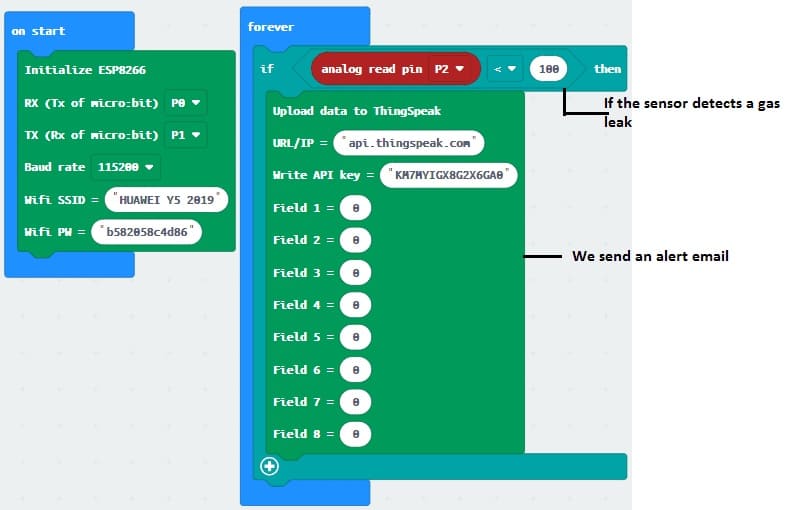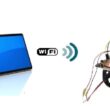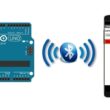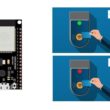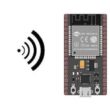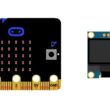Micro:bit smart gas leak detection system integrated with IoT

Tutorial plan
1- Role Smart Gas Leak Detection Systems
2- How our smart gas leak detection system works ?
3- Gas alarm system components
4- System assembly
5- Program the Micro:bit board with Makecode
Role Smart Gas Leak Detection Systems
A smart gas leak detection system integrated with IoT (Internet of Things) technology is an innovative solution designed to detect gas leaks, alert users, and prevent potential hazards such as fires or explosions. These systems leverage IoT to provide real-time monitoring, notifications, and remote management capabilities.
How It Works
1. Detection:
Gas sensors continuously monitor the air for specific gases.
If gas concentration exceeds a predefined threshold, the sensor triggers an alert.
2. Data Processing:
The microcontroller reads sensor data and determines whether a gas leak has occurred.
Alerts are sent to the IoT platform if a leak is detected.
3. IoT Connectivity:
Sensor data is transmitted to a cloud platform via Wi-Fi, cellular, or LoRa networks.
The cloud platform processes and stores the data.
4. User Alerts:
Notifications (via SMS, email, or app alerts) are sent to users.
Alarms or buzzers activate locally.
5. Action Execution:
The system can trigger safety mechanisms, such as closing a solenoid valve to stop gas flow.
6. Remote Monitoring and Control:
Users can access real-time gas levels and system status via a mobile app or web dashboard.
How our smart gas leak detection system works ?
The smart gas leak detection system is designed to monitor gas levels in an environment, detect gas leaks, and send real-time data to the ThingSpeak IoT platform for visualization and analysis. It uses the MQ-4 sensor to detect methane gas, the micro:bit as the main controller, and the ESP8266 Wi-Fi module to transmit data to ThingSpeak.
How It Works
1. Initialization:
The micro:bit initializes the MQ-4 sensor and sets up the ESP8266 Wi-Fi module.
The ESP8266 connects to the pre-configured Wi-Fi network using the SSID and password.
2. Gas Level Monitoring:
The MQ-4 sensor continuously measures methane levels in the air and produces an analog voltage output.
The micro:bit reads the sensor's analog output and converts it to a digital value using its ADC.
3. Threshold Detection:
The micro:bit compares the gas concentration to a predefined safety threshold.
If the concentration exceeds this threshold:
- The micro:bit displays a warning message on its LED matrix (e.g., "GAS LEAK!").
- A "leak detected" flag is set, triggering an immediate alert to ThingSpeak.
4. Data Transmission to ThingSpeak:
The micro:bit sends the gas concentration data to the ESP8266 via UART (serial communication).
The ESP8266 formats the data into an HTTP GET request and transmits it to ThingSpeak's REST API.
ThingSpeak stores the data in a channel, and it becomes available for visualization.
5. Alerts and Notifications:
ThingSpeak can trigger alerts when data crosses a threshold, using IFTTT Integration: To send SMS, email, or app notifications to users.
Gas alarm system components
1. MQ-4 Gas Sensor:
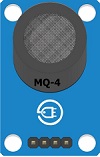
It detects methane (CH4) concentration and outputs an analog signal corresponding to the gas level.
2. Micro:bit:
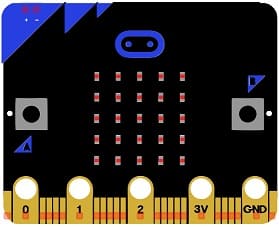
It Serves as the central controller for reading sensor data, processing it, and communicating with the ESP8266 module.
It reads the analog signal from the MQ-4 sensor through an analog pin.
It converts the analog value into gas concentration levels.
It implements logic to determine if gas concentration exceeds a predefined threshold (indicating a potential leak).
3. GPIO Expansion Board
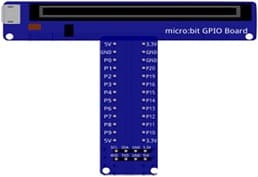
Provides additional GPIO pins for interfacing the ESP8266 WiFi Module and MQ-04 sensor with the Micro:bit.
4. ESP8266 Wi-Fi Module:
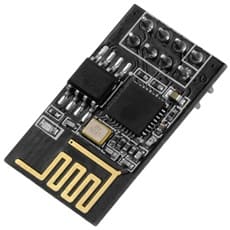
It connects to a Wi-Fi network and sends gas level data to the ThingSpeak platform.
It acts as a bridge between the micro:bit and ThingSpeak.
It uses HTTP GET requests to send data to ThingSpeak’s cloud server.
5. ThingSpeak IoT Platform:
It Sends email alerts (via integrations like IFTTT) when a gas leak is detected.
3V/5V power module
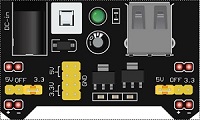
It supplies power to the micro:bit, MQ-4 sensor, and ESP8266 module.
6. Jumper Wires

Jumper wires will be used to make connections between the components.
7. Breadboard:

A Breadboard provides a platform to arrange and connect components without soldering.
System assembly
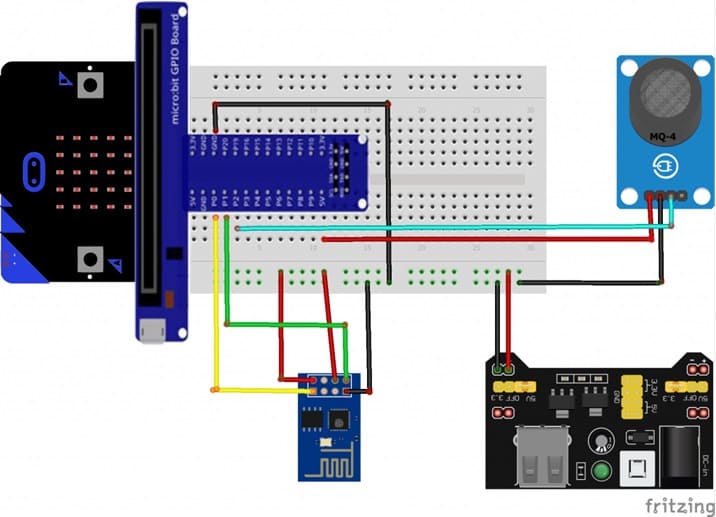
To perform the assembly, you can connect:
For MQ-4 sensor :
the DO pin to the P2 pin of the Micro:bit card
the VCC pin to the 5V pin of the GPIO card
the GND pin to the GND pin of the Micro:bit card
For ESP8266 module:
the RX pin to Pin P0 of the Micro:bit card
the TX pin to Pin P1 of the Micro:bit card
the GND pin to the GND of the Micro:bit card
the two pins 3V3 and EN to the 5V pin of the power supply module
Program the Micro:bit board with Makecode
1- Open the MakeCode editor.
2- Install ESP8266 extensions :
In the MakeCode editor, look for the "Extensions" option and click on it.

In the search bar, type "ESP8266," and add it to your project.
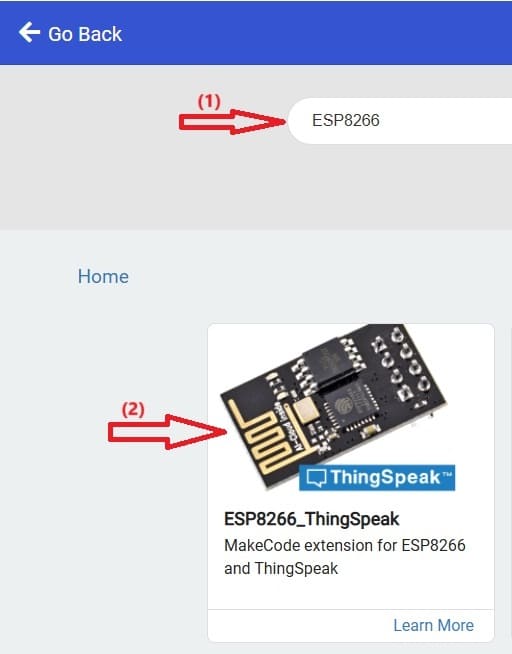
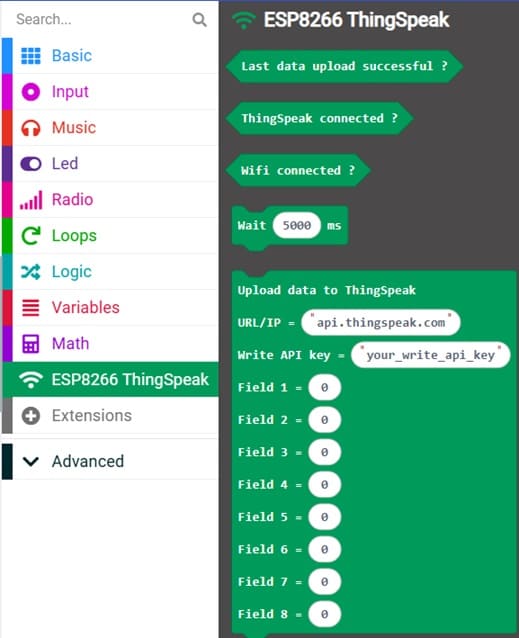
Finally, here is the program of the intelligent gas leak detection system connected to the Internet:
